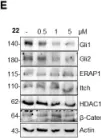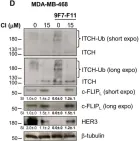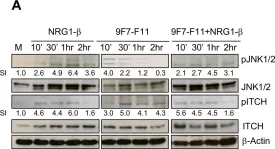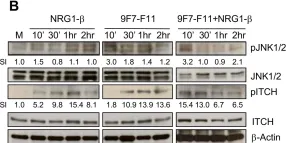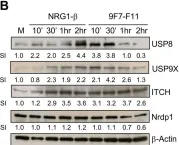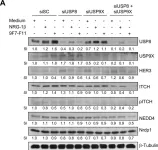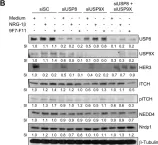Among the human E3 ubiquitin ligases, NEDD4 (Neural precursor cell expressed developmentally down-regulated 4) plays a critical role in development and cancer, making it a compelling therapeutic target. However, no specific NEDD4 inhibitors have advanced in drug development. In this study, we reveal the inhibitory mechanism of Norclomipramine, a tricyclic antidepressant, which inhibits NEDD4-mediated ubiquitin chain elongation by binding to a hydrophobic pocket in the Ub exosite of the N-lobe. Building on this mechanism, we conducted a focused medicinal chemistry campaign, resulting in the development of covalent inhibitors that specifically target the non-catalytic cysteine C627. These compounds exhibit selective binding to NEDD4 over other family members, effectively inhibiting NEDD4-mediated polyubiquitination while leaving monoubiquitinated substrates unaffected. Among these, compound 32 emerged as a potent lead (IC50 = 0.12 µM) with favorable pharmacokinetic properties, including oral bioavailability, paving the way for future in vivo efficacy studies.
© 2025. The Author(s).
Product Citations: 19
Structure-based design of potent and selective inhibitors of the HECT ligase NEDD4.
In Communications Chemistry on 28 May 2025 by Maspero, E., Cappa, A., et al.
In Life Science Alliance on 1 October 2022 by Romano, D., García-Gutiérrez, L., et al.
The RAS-RAF-MEK-ERK pathway is hyperactivated in most malignant melanomas, and mutations in BRAF or NRAS account for most of these cases. BRAF inhibitors (BRAFi) are highly efficient for treating patients with BRAFV600E mutations, but tumours frequently acquire resistance within a few months. Multiple resistance mechanisms have been identified, due to mutations or network adaptations that revive ERK signalling. We have previously shown that RAF proteins inhibit the MST2 proapoptotic pathway in a kinase-independent fashion. Here, we have investigated the role of the MST2 pathway in mediating resistance to BRAFi. We show that the BRAFV600E mutant protein, but not the wild-type BRAF protein, binds to MST2 inhibiting its proapoptotic signalling. Down-regulation of MST2 reduces BRAFi-induced apoptosis. In BRAFi-resistant cell lines, MST2 pathway proteins are down-regulated by ubiquitination and subsequent proteasomal degradation rendering cells refractory to MST2 pathway-induced apoptosis. Restoration of apoptosis can be achieved by increasing MST2 pathway protein expression using proteasome inhibitors. In summary, we show that the MST2 pathway plays a role in the acquisition of BRAFi resistance in melanoma.
© 2022 Romano et al.
-
Homo sapiens (Human)
-
Cancer Research
Preprint on BioRxiv : the Preprint Server for Biology on 22 February 2022 by Romano, D., García-Gutierrez, L., et al.
The RAS-RAF-MEK-ERK pathway is hyperactivated in almost all malignant melanomas, and mutations in BRAF or NRAS account for most of these cases. BRAF inhibitors are highly efficient for treating patients with BRAF V600E mutations, but tumours frequently acquire resistance within a few months. Multiple resistance mechanisms have been identified, due to mutations or network adaptations that revive ERK signalling. We have previously shown that RAF proteins inhibit the MST2 proapoptotic pathway in a kinase independent fashion. Here, we have investigated the role of the MST2 pathway in mediating resistance to BRAF inhibitors. We show that the BRAF V600E mutant protein, but not the wildtype BRAF protein, strongly binds to MST2 and inhibits MST2 pro-apoptotic signalling. Downregulation of MST2 reduces BRAF inhibitor induced apoptosis. In BRAF inhibitor resistant cell lines MST2 pathway proteins are downregulated by ubiquitination and subsequent proteasomal degradation rendering cells refractory to MST2 pathway induced apoptosis. Restoration of apoptosis can be achieved by increasing MST2 pathway protein expression using proteasome inhibitors. In summary, we show that the MST2 pathway plays a role in the acquisition of BRAF inhibitor resistance in melanoma.
-
Homo sapiens (Human)
-
Cancer Research
In Cell Death and Differentiation on 1 February 2022 by Yoon, S., Bogdanov, K., et al.
Phosphorylation of the pseudokinase mixed lineage kinase domain-like protein (MLKL) by the protein kinase RIPK3 targets MLKL to the cell membrane, where it triggers necroptotic cell death. We report that conjugation of K63-linked polyubiquitin chains to distinct lysine residues in the N-terminal HeLo domain of phosphorylated MLKL (facilitated by the ubiquitin ligase ITCH that binds MLKL via a WW domain) targets MLKL instead to endosomes. This results in the release of phosphorylated MLKL within extracellular vesicles. It also prompts enhanced endosomal trafficking of intracellular bacteria such as Listeria monocytogenes and Yersinia enterocolitica to the lysosomes, resulting in decreased bacterial yield. Thus, MLKL can be directed by specific covalent modifications to differing subcellular sites, whence it signals either for cell death or for non-deadly defense mechanisms.
© 2021. The Author(s).
-
WB
-
Cell Biology
In Cell Death and Differentiation on 1 February 2021 by Do, E. K., Moon, H. J., et al.
Oct4 plays a crucial role in the regulation of self-renewal of embryonic stem cells (ESCs) and reprogramming of somatic cells to induced pluripotent stem cells. However, the molecular mechanisms underlying posttranslational regulation and protein stability of Oct4 remain unclear. Using affinity purification and mass spectrometry analysis, we identified Kap1 as an Oct4-binding protein. Silencing of Kap1 reduced the protein levels of Oct4 in ESCs, whereas the overexpression of Kap1 stimulated the levels of Oct4. In addition, Kap1 overexpression stimulated the self-renewal of ESCs and attenuated the spontaneous differentiation of ESCs in response to LIF withdrawal. Kap1 overexpression increased the stability of Oct4 by inhibiting the Itch-mediated ubiquitination of Oct4. Silencing of Kap1 augmented Itch-mediated ubiquitination and inhibited the stability of Oct4. We identified the lysine 133 (K133) residue in Oct4 as a ubiquitination site responsible for the Kap1-Itch-dependent regulation of Oct4 stability. Preventing ubiquitination at the lysine residue by mutation to arginine augmented the reprogramming of mouse embryonic fibroblasts to induced pluripotent stem cells. These results suggest that Kap1 plays a crucial role in the regulation of the pluripotency of ESCs and somatic cell reprogramming by preventing Itch-mediated ubiquitination and the subsequent degradation of Oct4.
-
WB
-
Cell Biology
-
Stem Cells and Developmental Biology
In Cancers (Basel) on 9 October 2019 by Lospinoso Severini, L., Quaglio, D., et al.
Fig.5.E

-
WB
-
Collected and cropped from Cancers (Basel) by CiteAb, provided under a CC-BY license
Image 1 of 8
In Cell Commun Signal on 23 August 2019 by Le Clorennec, C., Lazrek, Y., et al.
Fig.5.D

-
WB
-
Collected and cropped from Cell Commun Signal by CiteAb, provided under a CC-BY license
Image 1 of 8
In Cell Commun Signal on 23 August 2019 by Le Clorennec, C., Lazrek, Y., et al.
Fig.2.A

-
WB
-
Collected and cropped from Cell Commun Signal by CiteAb, provided under a CC-BY license
Image 1 of 8
In Oncotarget on 14 June 2016 by Le Clorennec, C., Lazrek, Y., et al.
Fig.7.A

-
WB
-
Collected and cropped from Oncotarget by CiteAb, provided under a CC-BY license
Image 1 of 8
In Oncotarget on 14 June 2016 by Le Clorennec, C., Lazrek, Y., et al.
Fig.7.B

-
WB
-
Collected and cropped from Oncotarget by CiteAb, provided under a CC-BY license
Image 1 of 8
In Oncotarget on 14 June 2016 by Le Clorennec, C., Lazrek, Y., et al.
Fig.8.B

-
WB
-
Collected and cropped from Oncotarget by CiteAb, provided under a CC-BY license
Image 1 of 8
In Oncotarget on 14 June 2016 by Le Clorennec, C., Lazrek, Y., et al.
Fig.9.A

-
WB
-
Collected and cropped from Oncotarget by CiteAb, provided under a CC-BY license
Image 1 of 8
In Oncotarget on 14 June 2016 by Le Clorennec, C., Lazrek, Y., et al.
Fig.9.B

-
WB
-
Collected and cropped from Oncotarget by CiteAb, provided under a CC-BY license
Image 1 of 8
